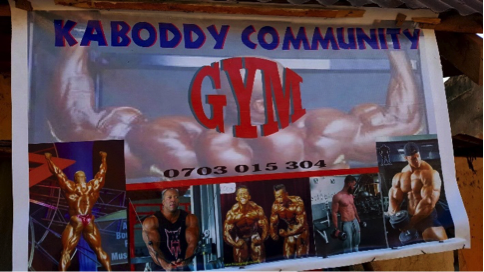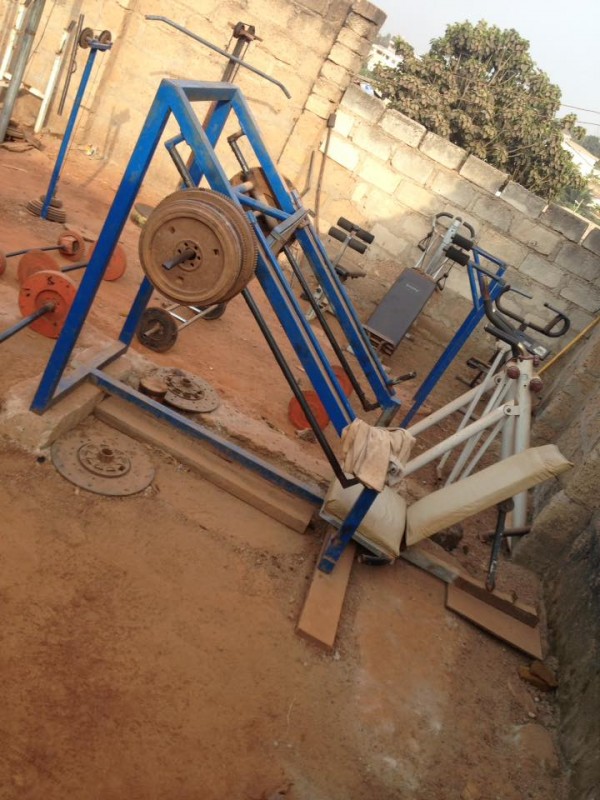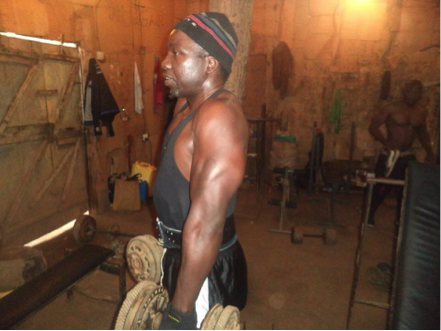
Author's Note: This article is mostly based on video evidence. If you don’t watch the videos, then the article doesn’t make sense.
What I am going to show you through pictures and videos in this article is what we always talk about here: lifting, strength, and sports. Nothing new to you. You will feel a slight estrangement at first, though, as if “it’s the same thing, but different.” On closer look, you will observe that the floor is not rubber, carpet, or wood — it is earth. The plates are frequently “peculiar”, and if you go back and watch again, you might see some vehicle gear wheels. Most bars are not Olympic. They are not even commercial. Soon it will sink in that the people training there built the whole training facility out of “unorthodox” material, sometimes scrap iron, sometimes car parts, sometimes cement or anything else that works. What really made these gyms possible was creativity and determination.
All these gyms are located in an area known as "Sub-Saharan Africa.” The countries I have some information on are Ghana, Cameroon, Nigeria, Uganda, and Kenya. With the exception of South Africa, Sub-Saharan African countries share many of the same adversities, including obstacles to set up a weightlifting gym. As in many areas of life, they improvise and get the job done.
RECENT: The Barbell: What It Is and How to Take Good Care of Yours
I have multiple goals with this article, but they are related. The first one is based on the principle according to which the only way to become a better human being is to get a grasp of the diversity of cultures, beliefs, and ways of doing things. That can result in tolerance, which is in dire need nowadays. The second goal derives from the first: we live in a pretty big world, with lots of people, and different people find different ways to achieve the same objectives. It is important to know that. It is called education. The third one is to reflect on the fact that we take most of our “way of life” for granted. The big deal for you may be choosing which plates to buy for your home gym, which is already outfitted with a rack and a few Olympic bars. You probably never wondered what you would do if there were no Olympic plates to buy. The fourth goal is to approximate us. We are one humanity, and here, we are the tiny part of humanity that shares the love for lifting. I hope you feel inclined to learn more about these gyms and maybe you will find other gyms in Sub-Saharan Africa that I’m not aware of. Maybe you make friends with them. And maybe we can all learn from each other. We can certainly use some of their creativity and they could probably use some resources we may feel inclined to send their way.
Sub-Saharan Africa: Where It Is, Who They Are, and What Training Is for Them
It is undeniable that we are united by the love for the iron. Lifting, sports, and training in Sub-Saharan Africa have very different objectives and health purposes than in the USA, though. As one of the economists I consulted told me, we have some data about North Africa and some data about South Africa, but Sub-Saharan Africa is a “big unknown.” Let’s shed some light there and make it less unknown for our readers, and hopefully gain some insight about what lifting means to the leaders of local initiatives there.
Economic development and inter-government agencies usually sub-divide Africa in two: North Africa, whose countries are members of the League of Arab States (LAS), and Sub-Saharan Africa, a large land located south of the Sahara. The classification varies. The United Nations, for example, considers Sudan as part of North Africa, although it is geographically located south of the Sahara. Also, Somalia, Djibouti, Comoros, and Mauritania are located south of the Sahara, but are part of the LAS.
(a) The Sub-Saharan African region as recognized by the United Nations; (b) in Red, the country members of the League of Arab States; (c) a rough climatic depiction of the African continent: the large Orange area is the Saharan desert; the yellow strip (the Sahel) and all yellow areas are semi-desertic savanna or steppe; light green represents savanna areas and dark green are rainforest areas. Source: UNESCO.
Source: USA Department of State
The reason for this division is not only climatic or religious. Sub-Saharan countries, with the exception of South Africa, share many of the same economic and social burdens. Organizations such as the International Monetary Fund, The African Development Bank, the World Bank, and the United Nations (IMF 2016, African Economic Outlook 2018, Global Economic Prospects 2017, HDR Report 2016, Kambou 2018), which have been measuring economic and human development indicators for decades, point out the challenges faced by the region. In spite of the high rates of economic growth until the dramatic drop in 2016, growth was not supported by economic and social measures that would provide stability and sustainability. Investment in infrastructure, formal employment, education, and anti-poverty policies were not adopted, population growth was significant, and the region was victimized by natural climatic disasters. These countries have mostly non-commodity intensive (oil, mineral resources) or agricultural economies. Industrialization is incipient and human development indicators are still a reason for concern:
Source: The 2016 UN-HDR Report
This unfavorable combination of factors resulted in increased poverty with economic growth. The Sub-Saharan African countries' GNI per capita from the HDR report shows that there are a lot of people and not so much wealth to share among them. That reflects on poor education, health, and quality of life indicators in general.
Their approach to popularizing physical fitness and sports is quite different from that of the industrialized world, where the chief nutrition and inactivity issues associated with poverty are obesity, macro- and micro-nutrient malnutrition, diabetes, cardiovascular disease, and other disorders secondary to those. Sub-Saharan Africa actually struggles with hunger (caloric and general malnutrition). There are direct and indirect forms of measuring hunger. The indirect form, most commonly employed, is the share of the population that has a caloric intake so low as to not meet the minimum physiological requirements. It is usually calculated based on data about the caloric intake in a given region and its population size. The direct forms are, for example, stunted growth in children and underweight (BMI less than 18) among adults. Unfortunately, all the indicators are consistent for Sub-Saharan Africa:
Source: Prevalence of underweight among adults, BMI less than 18, age-standardized. Estimates by WHO (World Health Organization).
The COHA project (Cost of Hunger in Africa 2016), in its first phase, has determined that:
- Today, there are more stunted children in Africa than 20 years ago.
- 69% to 82% of all cases of child undernutrition are not properly treated.
- Most of the health costs associated with undernutrition occur before the child turns one year old.
- Between 7% and 16% of grade promotion failure in school are associated with stunting.
- Stunted children achieve 0.2 years to 1.2 years less in school education.
- 8% to 28% of all child mortality is associated with undernutrition.
- Child mortality associated with undernutrition has reduced national workforces by 1% to 8%.
- 40% to 67% of working-age populations suffered from stunting as children.
While more affluent areas in poor countries, or more affluent countries themselves, have been following the western trend to improve fitness levels to fight diabetes and other inactivity-derived disorders (Statista 2018, Ooko 2018, Africa’s gym craze 2016), that is not the reality of Sub-Saharan African “street gyms,” social and community projects lifting initiatives, or even individuals trying to make a difference.
Few people know about these stories. In one of them, covered by Reuters, Tumi Masite, bodybuilding champion from South Africa, said, “Reg Park (Arnold Schwarzenegger’s former trainer) taught me a lot. He was also from a backyard gym. My dream became to reach out to the disadvantaged communities.” (Brock 2016)
The Stories I Found
Nana Kwabena Dwomoh Kontonkyi, from Ghana, at Kalle Beck’s Starting Strongman digital community, inspired me to dig the web for more information on the region, as he shared with us his gym, his initiative, and his reality. We were in awe.
The video below was made by Gus Kenworthy at the Nakivale Refugee Settlement in Uganda:
This is a refugee settlement that receives people from several African countries fleeing from war and famine. They evidently face issues such as insufficient supplies and conflicts. In the video, 24-year-old Masingo Christian, from Congo, describes a life of permanent fear and of always being ready to run from people who want to kill them. He reached the settlement with one of his brothers, but they lost the other brother and their parents on the way. Other refugees describe how the weights “clear their mind” from memories of war, relieve their thoughts, keep them healthy, and “complete” them. Below is Nana Kwabena Dwomoh Kontonkyi’s home gym in Ghana. In addition to the videos, he sent us some pictures of his equipment set up:
Also in Ghana, Kulbila Agyarko Samuel started a project and shared his videos on YouTube, where unfortunately we can’t find the fundraiser link anymore:
The Story of the Campaign
My Name is Kulbila Samuel and I'm from Akropong Akuapim in Ghana. Fitness is my passion and training in the gym has always been part of my life for a long time. Through my hard work and consistency in my environment, I have been able to change my life and also been able to inspire many youths from my local area who have now joined my fitness club. Through training together, we have been able to find a healthy escape from the harsh realities of life in our environment. We have managed to be more happy, strong, fit, and have love for one another.
Our local gym has been an alternative to criminal activities and a means of making us disciplined and more focused in life. I have been able to use the locally available equipment to transform them into gym equipment and this has really helped us. Through watching YouTube videos, we have been able to copy the designs of some equipment and also been able to learn how to use them to benefit us during workout sessions. We have been able to use old car parts and cement to come up with weights to use in the gym. We believe that through your help, we can manage to upgrade our gym and be able to buy some better locally made gym equipment that is similar to that professional equipment. We are hoping that there is someone out there who believes that we should upgrade our gym and get better equipment and would like to reach to that someone to kindly support us to make this happen. You can support us by making a donation, sharing this campaign with those in your life, and even by sending us an encouraging message that will keep us going. Thanks in advance.
The biggest challenge that we face is the climatic conditions, which tend to be harsh sometimes, making it very difficult to train. When the sun is out and it's too hot, we find it very difficult to train. It is also impossible to train when it's raining, because our gym gets flooded and some equipment becomes very dangerous to use when wet and slippery. That is the main reason why it would be very beneficial to build a gym that can protect us from the sun and the rain. Having a shelter a gym will be one of the best things that can happen to us. Please find it in your heart to support us in any way possible. And for those who enjoy fitness and going to the gym, we hope that you understand how important this is to me and my local boys. Be blessed.
Leslie Kofi Asare, also from Ghana, trains and competes in several strength sports, including CrossFit, bodybuilding, and strongman:
Leslie Kofi Asare
Leslie Kofi Asare posted a video to his timeline.
Below is Joel Essama, Cameroon’s weightlifting champion. Observe that, in spite of the slightly higher support he received because weightlifting is an Olympic sport, his training is also in an unsheltered area:
Meet Mercy Obiero, Kenya’s first female weightlifter. She started lifting encouraged by her brother, who was in the national team, and now trains other girls.
Also in Kenya, the improvised gym setup by one young man at his parents’ backyard attracts other boys for what young people want everywhere: to look sexy and attract partners. Pretty girls share their admiration for strong-looking boys much like everywhere else in the world. However, it was not only looking good for the girls that motivated these boys. They had to struggle to make their equipment out of cement and metal scraps. They also had to persuade their parents that it was a healthy activity. In the beginning, the adults didn’t accept it well. As they managed to show them that there was respect, no drugs, and it was an expression of discipline and protection from illegal activities, parents were more receptive. Little by little, they gained acceptance: one member is now a semi-professional rugby player, for example. The group was also featured in a pop singer’s video clip.
In Nigeria, Iyana Ipaja is a street gym where men and women lift improvised weights. People train there to get in shape, compete in strength sports, and even do the strength and conditioning work for other sports, such as boxing. The coach emphasizes that his people can be security guards or businessmen, but not criminals. His concern in using training as a means to provide a healthier and safer lifestyle is shared by local leaders.
This video from 2014 shows one of the four female weightlifters in Uganda training for the Commonwealth Games:
Later she moved to bodybuilding (and her training environment shows significant improvement over the one from two years earlier):
Still in Uganda, Sekiranda Tyson Kaboddy created a community gym whose mission statement includes, “impact moral behaviors and positive attitudes for affirmative development.”

If you watched all the videos you probably noticed that, except for one of the female weightlifters, the female bodybuilder’s environment, and Kaboddy’s community gym, they are all unsheltered and un-floored. As most of them explain, this is an even bigger challenge than the quality of the equipment, since excessive heat or excessive rain can make training impossible. Not to mention, of course, lack of food, as in the Refugee Settlement gym. In agricultural and non-industrialized areas, the poor struggle with caloric malnutrition (hunger) more than macronutrient and micronutrient malnutrition (obesity). We cannot offer a solution to poverty, but we can help with lifting, which, I hope, has been shown to be helpful in all circumstances. We can, at least, be a voice of encouragement and hope.
References
- Africa’s gym craze: beerbelly busters. The Economist. January 30th 2016.
- African Economic Outlook 2018. African Development Bank 2018.
- Brock, J. 'South Africa's Schwarzenegger' aims to lift poor with township gyms. Reuters, March 30, 2016. Consulted in 2018
- Global Economic Prospects: Sub-Saharan Africa. A Fragile Recovery. World Bank, June 2017.
- Health and fitness club membership* in Africa and the Middle East by country in 2016 (in 1,000s). Statista - The Statistics Portal. Consulted in 2018.
- Kambou, G. GLOBAL ECONOMIC PROSPECTS | JANUARY 2018. CHAPTER 2.6 .Sub-Saharan Africa. World Bank.
- Ooko, S. A gym for diabetes, asthma patients. Business Daily. Thursday, February 15, 2018
- Regional economic outlook. Sub-Saharan Africa. — Washington, D.C.: International Monetary Fund, 2003– v. ; cm. — (World economic and financial surveys, 0258-7440). International Monetary Fund, 2016
- The Cost of Hunger in Africa Social and Economic Impact of Child Undernutrition in Egypt, Ethiopia, Swaziland and Uganda. African Union Commission (AUC), the NEPAD Planning and Coordinating Agency, UN Economic Commission for Africa (ECA), and the UN World Food Programme (WFP) 2016.
- United Nations Development Programme. Human Development Reports. 2016 HDR Report.
- More About Sub-Saharan Africa
Acknowledgments
Nana Kwabena Dwomoh Kontonkyi, Leslie Kofi Asare (Fitboyleslie) and Sekiranda Tyson Kaboddy (of Kaboddycomgym, which has a Gofundme). I wish I could personally thank the other people I found through research. My gratitude to Kalle Beck, from Starting Strongman, as usual.



























Amazingly, the African people who have suffered so much and have faced so much adversity continue to demonstrate their intelligence, strength and perseverance.
Not sure if it was your intent, but speaking for myself, the videos of people training with the most basic of equipment (which required incredible innovation to build) in settings that are less than ideal (to put it mildly) causes me to reflect on how spoiled we are (especially here in the US).
Thank you for this article and the hard work that went in to producing it.
Joe
Thank you!